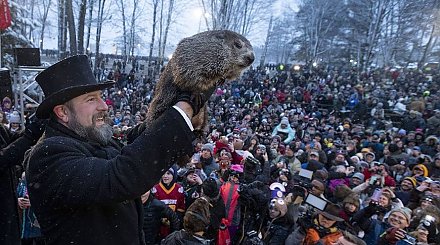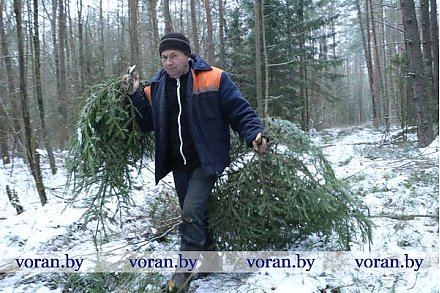Reference swamp, gray crane and cranberry placers
The republican biological reserve "Dubatovskoe" in the Smorgon region in its current form was formed in 2007.
On the basis of the reserve cranberry "Dubatovskoe", created in 1979, and the landscape reserve of local importance "Martishki (Berezy)". It is located in the basin of the Viliya river on the territory of the Dubatovskoye bog complex, 12 kilometers north of the regional center, on the lands of the forest fund of the Zhodishkovsky forestry of the Smorgon experimental forestry enterprise.Wildlife reserve
- The reserve arose within the boundaries of a zero peat deposit in a raised-type swamp Dubatovka to preserve valuable forest-bog ecological systems and habitats of small-leaved bog cranberries, as well as wild animals and wild plants included in the Red Book, says Sergey Golubev, the head of the Smorgon City District Inspectorate of Natural Resources and Environmental Protection. - Its area is 839.5 hectares. The territory includes forest bog landscapes with areas of upland, lowland and transitional bogs. The peat-bog type of soil, pine-sedge pubescent-sphagnum peat dominates. The relief is mostly boggy.

Among the bogs there are two medium-sized reservoirs, in which there is no vegetation due to high acidity. The main forest-forming species of the reserve are pine, birch, spruce and aspen. Birches on the water are a typical picture for today's places.
- In the reserve it is strictly forbidden to carry out any work, to kindle fires (peat flashes instantly), to set up camps, to arrange parking for vehicles, continues Sergey Valerievich. There are no ecological paths and no influx of tourists, and only within a strictly set timeframe, with permits, it is possible to collect cranberries.

Peat deposit and "Red Book" species on hummocks
The basis of the reserve is a classic raised bog massif of the Baltic type with two picturesque lakes. According to scientists, the virgin swamp in the reserve was formed during the ice age. Its age is more than seven thousand years. The reference swamp!

The fact that a raised bog is located in the Grodno region is unusual in itself, notes Andrei Petrovsky, deputy director of the Smorgon experimental forestry enterprise. - This is a Baltic type swamp - like Yelnya, Dolbinishki. It was not affected by civilization and land reclamation - it remains in an absolutely natural state.

The convexity of the bog surface above the adjacent mineral shores is up to four meters or more. The Dubatovka peat deposit is located here, the peat deposit of which is composed of high-moor peat almost to its entire depth. The total area of the deposit is 644 hectares.

The biological function of bogs is that they are habitats of specific flora and fauna, notes Oleg Sozinov, head of the Department of Botany at Yanka Kupala State University of Grodno. - Swamp species cannot exist in other habitats, for example, in dry meadows, forests, steppes or water bodies. The destruction of wetland habitats inevitably leads to a decrease in biodiversity, therefore, it is a great danger. In terms of the scale of manifestation, the biological function of bogs belongs to the global level, since many species of bog diversity annually migrate beyond individual continents.
The vegetation cover of the raised bog "Dubatovskoe" is dominated by various types of moss ¬ phagnums, which, together with marsh shrubs and dwarf shrubs (wild rosemary, cranberries, marsh myrtle, andromeda, etc.), form a classic spacious marsh relief with hummocks, ridges and hollows. In general, the landscape of an open raised bog resembles ... a tundra.

- We with students studied this swamp massif on expeditions,continues Oleg Vladimirovich. On the territory of the reserve, three “Red Book” plant species were found: small-fruited cranberries grow on sphagnum bumps, green hollyleaf orchid grows on damp cannons of birch forests, and mountain arnica in mossy pine forests on the mineral “islands” of the reserve. Also within the boundaries of "Dubatovskoe" there are more than ten species of ornamental and medicinal plants included in the list of wild-growing ornamental, medicinal, food and other economically useful plant species that need preventive protection and rational use. These are marsh cinquefoil, marsh cranberry, common loosestrife, three-leafed watch, heather, plakun ¬ grass (loosestrife), yellow iris, meadowsweet and others.

The forests around the bogs are liquid, mixed, mainly pine and birch, heavily watered. They grow very slowly, as if they are tormented on the water ...
- The main feature of the reserve is the plantation of small-fruited cranberries, which grows mainly in the central part of the reserve on hummocks together with bog cranberries, - says Alexander Bibik, forester of the Zhodishkovsky forestry of the Smorgon experimental forestry enterprise. - This valuable berry is rarely found in the Grodno region.

It is not easy to walk through the raised bog, you need to know the paths - there are transitions from one swamp to another. Andrey Petrovsky and Alexander Bibik are excellent guides, you won't get lost with them. They will also lead to the 40-meter Lysaya Gora - a kind of observation deck from which you can see the swamp, enjoy the beauty of the local landscapes and listen to the bird's polyphony. From there it is clearly seen that part of the bog is not covered with woody vegetation, birch prevails on one part, pine on the other, and even part of the lake will open to the eye.


Crane Symphony
A huge number of birds gather on unnamed lakes, especially in spring. And the most amazing and beautiful are cranes, large water-marsh birds. Cranes in Belarus are a symbol of longevity, good luck and happiness. Every autumn they fly south to return later in the spring. There are 15 species of cranes in the world, and the rarest of them is the gray one. It was this species that was chosen by the Dubatovskoe swamp.
- In the spring they gather at Dubatovskiy, defend their sites, shout, says Alexander Bibik. And during the breeding season (April to July) this beautiful bird symphony only stops briefly in the afternoon. The voice of the crane is trumpet, beautiful. The echo carries sounds far away. During the mating season, the male and female perform beautiful ritual dances. At the best of times, we counted up to 60 pairs of cranes. And how beautifully they fly like a wedge!

By the way, gray cranes are monogamous: they are faithful to one female (male) all their lives. However, they are omnivorous: they feed on plants, berries, small vertebrates, fish. In autumn they love corn - they organize "raids" on the fields of the local agricultural enterprise.
Representatives of the leshoz told us that there are many snakes, lizards, and even marsh turtles in the swamps. Traveling around the reserve, you can find traces of the habitat of an elk, wood grouse, wild boar, roe deer, fox, and wolf. Animals and birds feel at ease here, sometimes they go out to people. The fauna of the reserve is represented by 78 species of animals, including 58 species of birds. Of these, the gray crane and the badger are protected species.

People in the swamp
On the edge of the swamps, small cozy villages with beautiful names huddle - Dubatovka, Birch, Chernyaty, Abramovshchina, Lazovka, Goridenyaty, Lipki farm ... It is believed that the swamp and the reserve got their name from the Dubatovka settlement, known since the 14th century. Its Slavic name, surrounded by Baltic place names, suggests that this settlement stood here in pre-Christian times. By the way, the locals call their village Dubatovki - in the plural.
In the 16th century, the Dubatovka estate belonged to the Soly estate, which belonged to the elder Jan Radziwill of Zhmutsky; later, Stanislav Kishka, Zavadsky and Klimansky were among the owners. The village is surrounded by forests and swamps. "The dull plain of the peat bog" is incredibly similar to the description of the places near Korotkevich in "The Wild Hunt of King Stakh". And the surname of one of the characters - Hryn Dubatovk - couldn't it have been borrowed from the name of the town and the swamp ?!

The center of a small village is a chapel. Until 1839, there was a Uniate church in the town, then an Orthodox church, completely destroyed during the First World War. In 1939, when the land was in the possession of Poland, a Catholic chapel was built on this place. In the early nineties of the last century, the word of God sounded here again.
The dugouts built during the First World War have been preserved right in the village. There are many traces of that war left in the Smorgon region; the line of the Russian-German front passed through the region from September 1915 to February 1918. Such shelters were used against shelling.
And in the Great Patriotic War, local residents rescued a young pilot Tabakov from a wrecked attack plane that fell into a swamp. Then for many years he personally and in writing thanked the villagers for his salvation. Pavel Sukhoi, a great designer, lived in Dubatovka for several years as a child. His dad taught at a local school, and from here they moved to Gomel.
-A little more than thirty inhabitants remain from the once large village, says Alexander Bibik. - But there are those who really love these places, nature and consider themselves a part of this amazing system. My wife and I are rooted in the homeland of our ancestors - grandmothers and grandfathers - and are happy that we enjoy peace and harmony with nature.
There were times when villagers dug peat without permission to make briquettes and heat houses, hay was harvested from swamps, garbage was thrown directly into the woods by the swamp ...
- Today it is not. People began to understand that the reserve is our common wealth, which we must pass on to children in an intact form, and living in beauty, without breaking harmony, is important for the health of the body and, most importantly, the soul, ”sums up Alexander Viktorovich.

Zhodishki. The old mill, everything will change ...
Near the Dubatovskoye reserve is the agricultural town of Zhodishki, which is favored by tourists. Zhodishki have been known since the beginning of the 16th century. The town has a Baltic name, which means "flowering shores". And it stands on the beautiful flowering banks of the Viliya River. In 1774, the king of the Polish-Lithuanian Commonwealth Stanislav August Poniatovsky endowed Zhodishki with Magdeburg Law.
Eight years ago, episodes of the film from the series "State Border" were filmed in Zhodishki. An incredibly beautiful pond, a bridge, and near it - an operating water mill of the 18th century - all this could be seen in the frame. The mill, by the way, was bought and restored by the heir of the former owners - Franz Zhilko. It is the only old operating water mill on the territory of Belarus. Grind flour with millstones using water. In the building of the mill there is a museum of the water mill, where you can truly feel the spirit of antiquity.


And in the Church of the Most Holy Trinity, founded as a Calvin collection in 1612, the murals made by the Belarusian artist Peter Sergievich are striking. The frescoes show the villagers. The artist copied characters for traditional biblical subjects from peasants. Here, on holidays and Sundays, an organ sounds more than three hundred years old.
The building of the former Jesuit collegium is also impressive in Zhodishki. It is well preserved, now it belongs to the regional medical institution. Unique places of stunning beauty are a godsend for a tourist. Nearby is the White Mountain, the country's only open-air climbing wall (!), The sheer banks of the Viliya - in these places it is somewhat reminiscent of the Altai mountain river.

Great river
One can endlessly talk about Viliya, which, by the way, is fed by numerous rivulets and even a brook from the Dubatovskoe bog. The right tributary of the Neman, a river of two countries - Belarus and Lithuania, is one of the ten main rivers of our country. It supplies water to two large cities - Minsk and Vilnius, the energy of its waters is used to generate electricity for the Vileika hydroelectric power station. The river is incredibly meandering and beautiful, with low, cozy, and sometimes high, steep banks, covered with forest. One of the rivers most beloved by tourists attracts not only residents of Belarus, but also neighboring Lithuania, Poland, and Russia for rafting.
“Local residents call the river Vella and claim that its name comes from the word“ great ”,” says Andrey Petrovsky. - Once upon a time it was full-flowing, navigable, timber was rafted along it. In the waters of the great river, pike, perch, roach, bream, tench, crucian carp, perch, pike perch, brook trout, eel, and burbot are found. But Viliya's main fish value is the salmon trout, which comes here straight from the Baltic for spawning. And seagulls, swans, cormorants, egrets and gray herons, various representatives of the duck family, beavers, otters, roe deer, deer and other representatives of the fauna feel absolutely safe by the river.
Beautiful virgin nature, coupled with unique cultural and historical monuments, makes the Smorgon region unique.
The Krevo Castle, the Museum Estate of Michal Kleofas Oginsky in Zalesye, the Museum Estate of Frantishk Bogushevich in Kushlyany, the camp of primitive people near the village of Lazovka, numerous temples are places of power where every Belarusian must visit at least once in his life. To understand why the great people of the small homeland - composer Mikhail Kleofas Oginsky, ethnographer linguist Jan Karlovich, composer-conductor Mechislav Karlovich, writers Frantisek Bogushevich, Marian Duxa, sculptor Vladimir Terebun, scientist Grigory Zalessky and others, so loved these endless expanses, mysterious swamps, flooded meadows and virgin forests ...
https://grodnonews.by/






